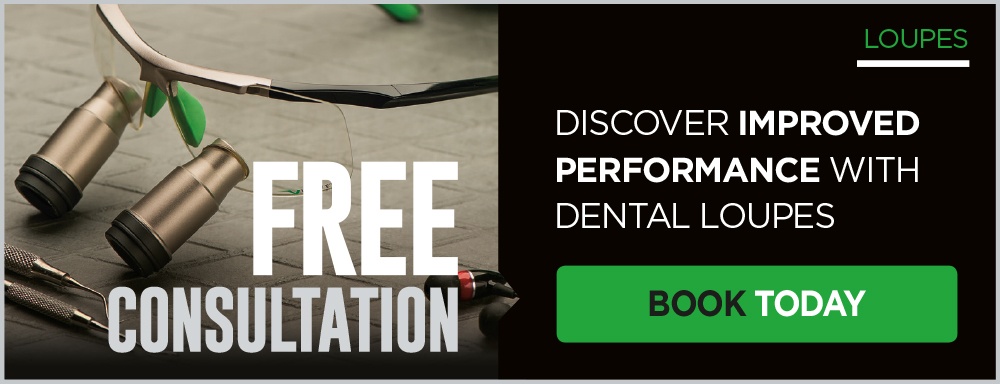Dental professionals can benefit from the routine use of correctly prescribed Dental Loupes and Lighting. In this blog, we explain how the adoption of a correct working posture can improve both their efficiency and overall health.
"Good dentistry is not just about using the latest, most advanced materials and hi-tech gadgetry!"
One of the more basic and essential elements that can significantly contribute towards achieving better dentistry, is the way that the practitioner positions him or herself at the chairside.
It is essential to have an understanding of just how useful ‘dental ergonomics‘ and the adoption of correct working positions is, together with the use of customised optical aids and associated lighting, as it enables practitioners to work with less physical stress, more comfort, and will invariably result in achieving better dentistry.
The concept of dental ergonomics is not new, but before the advent of four-handed dentistry, many dentists who worked in the upright working position suffered from head, neck and back strain.
How Can Dental Loupes and Lighting Help Dental Practitioners?
Prior to the 1980s, the use of any magnification in dentistry, such as loupes, was rare, and it could sometimes be difficult trying to achieve successful results in more demanding areas, like endodontics and implant surgery.
Many practitioners will be familiar with the teachings of Ellis Paul, a pioneer in the application of dental ergonomics who, from the inception of four-handed dentistry in the early 1960s, applied his own philosophy on the correct ways of working. This philosophy is based on working efficiently, with attention being paid to the ergonomics of seating, posture, the correct positioning of operator and assistant, coupled with correct vision and lighting. It has stood the test of time and is still being taught today.

Many dental practitioners experience problems with back, neck and shoulder pains, making their daily chairside work and associated procedures uncomfortable. Sometimes this causes need for remedial help through osteopaths and chiropractors, or in extreme cases, surgical intervention.
Not only do dental loupes help improve posture by offering a steeper declination angle in order to minimise the risk of developing a sore neck and back pain, but also loupes can help reduce eye strain, easing the pressure on the eye muscles and allowing dental practitioners to maintain the required focus while minimising the eye fatigue.
It is clear that dentists and hygienists have an obvious need to invest in dental loupes to improve posture, reduce eye strain and to achieve better visual acuity.
Why Use Dental Loupes and Lighting?
Practitioners’ jobs have been made somewhat easier as dental loupes have become widely accepted by dental professionals, but it is a common perception that loupes are only an aid to better vision, rather than an instrument that also improves posture and working positions.
Good eyesight is an essential element in the production of better dentistry so careful attention is needed when loupes are prescribed. Cheap off-the-shelf loupes may satisfy the practice budget, but will not be the answer to a practitioner’s needs, as they will require the wearer to ‘adapt’ to optics that may not suit their eyesight, which might also prove detrimental to their sight in the long term.

There are many things to look for when buying dental loupes and with many available, it is useful to consider all options before buying dental loupes and lighting.
Customised loupes, made to the exact requirements of the individual practitioner are recommended by Optident. This will be dependent upon the procedures for which they will be required. General dentistry and prophylaxis work will only require a relatively low level of magnification, whereas implantology or endodontics will demand lenses with a much higher magnification.
Booking a face-to-face consultation is highly recommended when buying customised dental loupes. There are now many different types of loupes available. These can be of a conventional telescopic design, with either Galilean or prismatic lenses.
Another consideration is lighting. This can prove to be extremely beneficial when linked with correctly prescribed magnification. Lightweight battery-powered lighting that can deliver focused, intense and colour-correct light into localised mouth areas have now overcome the shortcomings of the previous introduced halogen types.
Requirements For Fitting Dental Loupes and Lighting
In all instances a clear understanding of the exact requirements of the wearer will be necessary, so that the best possible prescription can be drawn up and the magnification produced is specifically for that individual.
Therefore, it is necessary to look at a total concept prescription that incorporates all these elements when attempting to satisfy all the practitioner’s needs in regards to vision, lighting and posture. It must take account of the operator’s body posture, resultant working position, magnification requirement, their sightlines, angles of sight, lighting and seating.
Correctly determined prescriptions for magnification and lighting, together with adoption of comfortable working positions will invariably result in the operator gaining much improved visionary advantage, better health, with less likelihood of work incapacity and time lost through head, neck and shoulder pain.
Improved working conditions for dental practitioners will improve procedure and treatment quality for the patient, helping deliver a better level of service.

